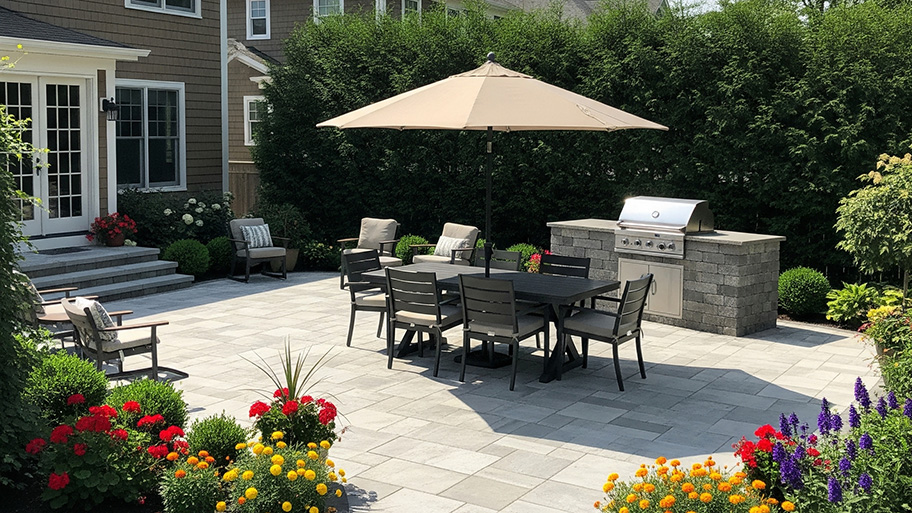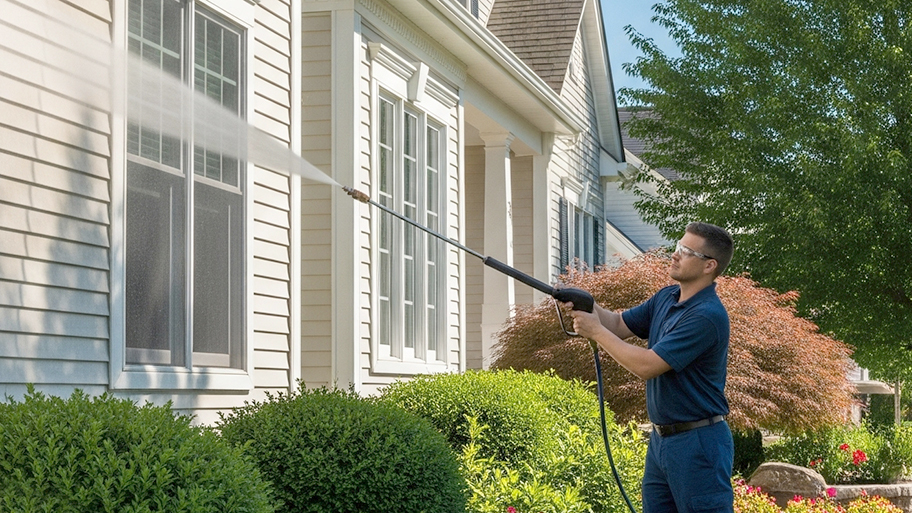
Pressure washers can help you keep your home looking great. Use this guide to learn how much it costs to rent a pressure washer based on factors like type and time.
Here’s everything you need to know—including the safety risks involved—about this heavy-duty cleaning method


Bathroom features like tubs and showers are havens for gunk and grime because of extended water exposure, and pressure washing can be a good way to restore their original glory with minimal physical effort. But before committing to this cleaning style, it’s important to know about the risks that it can pose to both yourself and your bathroom and prepare accordingly to get the best results. The following guide breaks down why you might (or might not) choose to go this route, plus exactly what to do to stay safe if you do.
Be prepared to discuss your home size, number of floors, and home layout with your pro.
Mention what materials you have on or around your home that you want pressure washed.
Ask your pro if they use cleaners and ensure they’re safe for use around plants and pets, if applicable.
Discuss any add-on services you want, like soft washing for your roof, concrete sealing, or gutter cleaning.
While it should never be your first choice to use a pressure washer indoors, you might want to consider pressure washing your shower or bathtub if you’ve tried every other method to remove grime with no luck.
We do not recommend using a pressure washer indoors as a DIYer. You should call a cleaning company for advice first, and get in touch with a local pressure washing company if you need more help understanding the logistics and dangers. If the pros think pressure washing your shower is the only good solution for your situation, they can guide you on next steps.
Although pressure washing indoors isn’t recommended because of physical hazards and the damage it can cause to delicate interior fixtures, the following steps will help you stay as safe as possible during the process.
Gas-powered pressure washers are a big no for indoor use for a couple of reasons. For one, they emit dangerous carbon monoxide fumes that can be especially hazardous when working in closed spaces. Plus, they are more pressurized than electric alternatives and therefore more likely to cause damage to things like tile and grout.
A common pressure washing mistake is not protecting your fixtures. Although you can adjust a pressure washer to be more or less forceful overall, there are some bathroom elements that may be damaged even if your machine is set on low. The high pressure can tear apart reapplied caulks, weak seals, or delicate fixtures. In general, you’ll want to avoid pressure washing things like caulk, sealant, or a tub or shower that’s been refinished as these features are extremely delicate to begin with.
The last thing you want to have to worry about while cleaning your tub or shower is tripping over a cord, so be sure to choose a wireless pressure washer for such tasks if possible.
Even if you’re extremely careful about where you point the nozzle, there’s still likely to be overspray when using a pressure washer. Keep yourself safe from slippage by having towels or mop handy for quick drying and wear shoes that won’t slip and slide.

Once you’ve carefully considered whether you can do the job safely, read through these tips to get your shower or tub spick-and-span in no time with a pressure washer.
Before getting started, make sure you have the following tools and materials at your disposal.
Electric pressure washer
Green 25-degree nozzle
Garden hose
Mops or towels
Shower brush or abrasive cleaning pad
Closed-toe, non-slip shoes
Goggles
Plastic sheeting
Duct tape
Choosing the right nozzle for such a project is of the utmost importance. If you can’t obtain a green, 25-degree nozzle, a yellow, 15-degree nozzle is the next best bet. Never use a zero-degree red nozzle for indoor uses because such a high concentration of pressure will almost certainly damage your shower or tub.
Remove anything from your space that might get in the way or become damaged during the power washing process before beginning. That includes everything inside of your shower or tub, like shower caddies, soaps and shampoos, and loofahs, as well as anything nearby that may be affected by overspray, like bath mats or electric appliances such as hair dryers or toothbrushes.
When everything is removed, cover the floor and bathroom features like the sink and toilet with plastic sheeting, and use duct tape to seal tightly.
You’ll need to attach your pressure washer to an external water source whether or not it’s cordless. In most cases, this will be your garden hose. Place the pressure washer outside but close enough to your bathroom that it can reach your shower or tub without difficulties (usually by a window).
From there, connect the pressure washer to your hose and place it through the closest window or door into your bathroom. Then, if it’s not cordless, plug the pressure washer into a GFCI (ground-fault circuit interrupters) outlet to prevent electric hazards. Fortunately, it won’t be difficult to find one because this type of outlet is mandatory in bathrooms.
Finally, start cleaning with your pressure washer set on low. If you find that that’s not enough, gradually increase until you get the desired effect.
Moving the nozzle horizontally, begin at the top of your shower or bathtub walls, and work your way downward. Working in the opposite direction will push debris upwards and make the cleaning process both lengthier and more difficult.
Once you’ve reached the bottom of your shower walls, turn off your pressure washer and finish the rest by hand. Use an abrasive cleaning pad or electric or manual shower brush to remove grime from the caulk or sealant at the base of your walls.

If you’d rather avoid the added costs of pressure washing, the following tips will stop grime before it becomes necessary.
Aim to scrub your shower or tub walls once every one to two weeks to prevent extreme gunk and grime build-ups. The longer you let it accumulate, the more likely an intensive solution like pressure washing will be necessary.
Scrubbing dirty shower or tub walls clean by hand is much easier to do if you first apply a solution to loosen it up. Before resorting to pressure washing, try applying one of the following solutions to clean your shower first.
Equal parts baking soda and warm water
One part water and two parts vinegar
Equal parts bleach and water (remember never to mix bleach with any other chemicals)
Store-bought grout and tile cleaning solution
Not having to do an arm workout to get a clean shower is undeniably the biggest draw of pressure washing, but there are other tools that are less invasive but will still cut down on your workload. Electric bathroom scrubbers are wireless, easy to maneuver, and will do the majority of manual labor for you. They are also way less likely to damage tub or shower features in the process.
The cost to hire a house cleaner near you to clean your shower or tub isn’t too high: about $30 to $50 per hour. Pressure washing services specifically range from $100 to $750 for both indoor and outdoor features like pressure washing a fence. By contrast, you’ll pay far less to do it yourself if you decide to rent rather than buy a pressure washer. If you’re worried that you aren’t skilled enough to operate the machine safely, though, you may be better off leaving the job to a pro.
From average costs to expert advice, get all the answers you need to get your job done.

Pressure washers can help you keep your home looking great. Use this guide to learn how much it costs to rent a pressure washer based on factors like type and time.

The cost to pressure wash a patio depends on the size of the surface and the type of patio you have, as well as whether you DIY or hire a pressure washing pro.

Need to breathe new life into your dirty siding and trim? Explore the cost to pressure wash a house to boost your curb appeal instantly.

Considering DIY pressure washing your home instead of hiring a pro? We’ll help you weigh the pros and cons of each option.

Your house sees a lot of rain, snow, dirt, and debris over the seasons. So, how often should you power wash your house? Find out with this guide.
Pressure washers have many uses from cleaning patios to scrubbing cars. This guide covers the most common pressure washer uses to help you make the most of this tool.